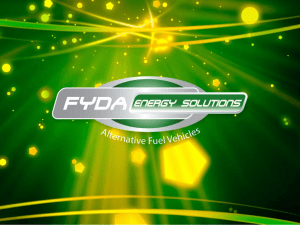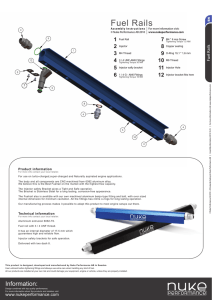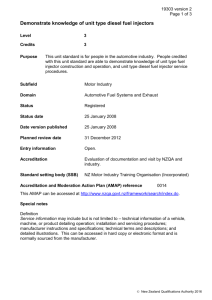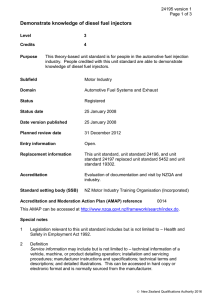6.4L Injector Pre-Installation and Installation Information
advertisement
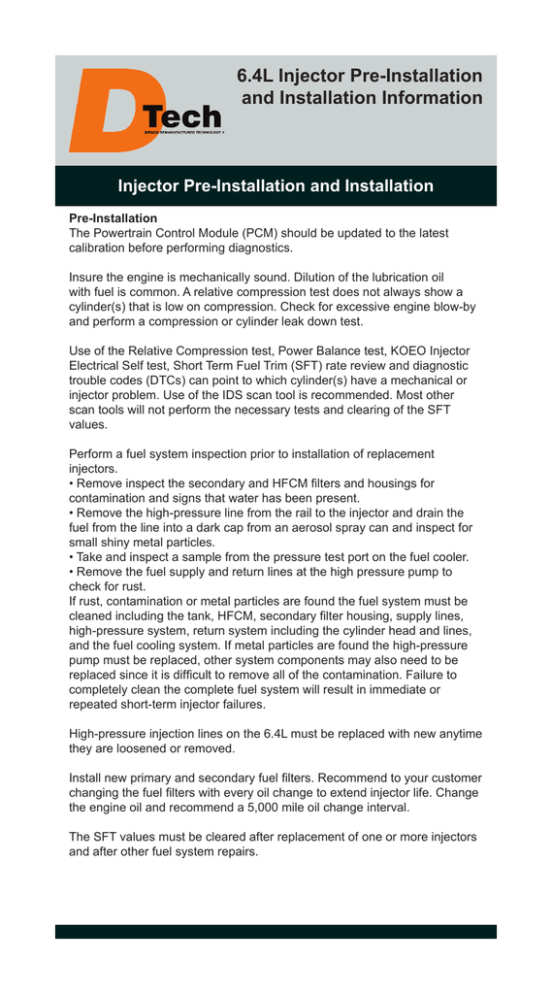
6.4L Injector Pre-Installation and Installation Information Injector Pre-Installation and Installation Pre-Installation The Powertrain Control Module (PCM) should be updated to the latest calibration before performing diagnostics. Insure the engine is mechanically sound. Dilution of the lubrication oil with fuel is common. A relative compression test does not always show a cylinder(s) that is low on compression. Check for excessive engine blow-by and perform a compression or cylinder leak down test. Use of the Relative Compression test, Power Balance test, KOEO Injector Electrical Self test, Short Term Fuel Trim (SFT) rate review and diagnostic trouble codes (DTCs) can point to which cylinder(s) have a mechanical or injector problem. Use of the IDS scan tool is recommended. Most other scan tools will not perform the necessary tests and clearing of the SFT values. Perform a fuel system inspection prior to installation of replacement injectors. • Remove inspect the secondary and HFCM filters and housings for contamination and signs that water has been present. • Remove the high-pressure line from the rail to the injector and drain the fuel from the line into a dark cap from an aerosol spray can and inspect for small shiny metal particles. • Take and inspect a sample from the pressure test port on the fuel cooler. • Remove the fuel supply and return lines at the high pressure pump to check for rust. If rust, contamination or metal particles are found the fuel system must be cleaned including the tank, HFCM, secondary filter housing, supply lines, high-pressure system, return system including the cylinder head and lines, and the fuel cooling system. If metal particles are found the high-pressure pump must be replaced, other system components may also need to be replaced since it is difficult to remove all of the contamination. Failure to completely clean the complete fuel system will result in immediate or repeated short-term injector failures. High-pressure injection lines on the 6.4L must be replaced with new anytime they are loosened or removed. Install new primary and secondary fuel filters. Recommend to your customer changing the fuel filters with every oil change to extend injector life. Change the engine oil and recommend a 5,000 mile oil change interval. The SFT values must be cleared after replacement of one or more injectors and after other fuel system repairs. Injector Installation Injector Installation 1. Use caution when working on the fuel system to prevent injury. The highpressure side of the fuel system is pressurized up to 26,000 PSI and the injector wiring high voltage exceeds 100 volts. Make sure the engine is off, the high-pressure has bleed down and the engine has cooled off prior to working on the fuel system. 2. DTech fuel injectors have tolerances measured in microns. It is important to work in a clean manner to prevent contamination of the fuel system to prevent premature failures. 3. Do not use air tools to remove the injectors. This may damage the injector hold-down clamp bolt retainer. Insure that any retainers that come off or pieces of broken retainers are removed to prevent severe engine damage. The oil drain holes near each glow plug can be plugged with a clean rag to prevent pieces or whole retainers from falling into them. 4. Make sure that the injector bore is clean and that the old nozzle-sealing washer has been removed. 5. Lubricate the injector body o-ring with clean engine oil. 6. Insure the bead on the steel nozzle-sealing washer is facing the cylinder head. 7. Install the injector and initially torque the hold-down bolt to 18 in-lb (2 Nm). 8. To tighten the high-pressure injection line nut use a back-up wrench on the injector inlet fitting. Use a crowfoot wrench to tighten the nuts. 9. Snug up the nuts on the two inside lines and then the two outside lines. 10. Torque the injector hold-down bolt to 28 ft-lb (28 Nm). 11. Pre-torque the line nuts to 106 in-lb (12 Nm). Important, when using a crowfoot wrench determine the proper torque value using the formula below. 12. Use a permanent marker to mark a reference line on the nut and the inlet fitting. 13. Tighten the line nuts 60 degrees to achieve the final torque. 14. Bleed the fuel system. 15. Clear all DTC and the Short Term Fuel Trim (SFT). Torque Wrench Setting C = Desired Torque D x (A ÷(A + B)) Injectors submitted for warranty that are damaged by contamination or with combustion blow-by are not covered under the DTech warranty.
